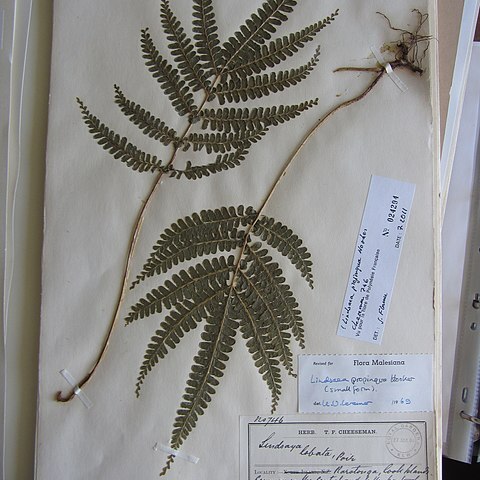Rhizome short-creeping, 1.5-2 mm ø; scales reddish brown, narrowly triangular, to 1.5 mm long, to 8-seriate at base, with a short uniseriate apex. Leaves close; petioles stramineous, abaxially at least in the upper part obtusely or usually acutely bi-angular and often sulcate, 10-40 cm long, 0.5-1.5 times as long as the lamina. Lamina simply pinnate or in full-grown plants (probably always) bipinnate, with 1-2 pinnae to a side and a conform but sometimes larger terminal one, 10-30 cm long; primary rachis of bipinnate leaves like the upper part of the petiole. Pinnae obliquely patent, narrowly oblong, like simply pinnate laminas, 10-20 cm long, 2-4 cm wide, acute or shortly, rarely more long-acuminate; pinnule-bearing rachises abaxially sharply bi-angular or shallowly sulcate, the edges sometimes slightly wing-like. Pinnules c. 12-30 to a side, less than their width apart to contiguous, spreading to somewhat ascending or, especially in smaller, simply pinnate laminas the basal ones decurved, herbaceous, medium to dark green when dry, trapeziform to rhombic, or in larger leaves often ligulate or truncate-ligulate, not very rarely with a slightly protracted apex, the larger ones 12 by 3 to 19 by 7 mm, almost 2.5 to 3 times as long as wide, usually little narrowed; upper margin straight or convex outward, a separate outer margin present, joining the upper at right angles or more often at an acute angle, less often rounded into the upper margin; upper margin of larger fertile pinnules with 1-3 narrow oblique incisions to 1 mm deep, the outer margin occasionally with one incision; smaller pinnules often entire; sterile margin shallowly crenate; fertile margin not erose; lobes flat. A few upper pinnules strongly reduced, or less often many, 1 or 2 or a few connected with the narrow, acute, asymmetrically lanceolate terminal segment. Veins immersed, evident or not, regularly anastomosing, forming one (very rarely parts of a second) series of areoles, the larger ones 0.75-1.25 mm wide. Sori interrupted by the incisions, the sorus on the outer margin mostly continuous with the outermost one of the upper. Indusium pale or greenish, entire or almost so, 0.2-0.3 mm wide, not reaching the margin by an equal distance or usually less, little reflexed and scarcely concealed at maturity. Spores pale brown, trilete, smooth, c. 20 μ.
More
Rhizomes shortly creeping, sparsely scaly; scales appressed, reddish brown, narrowly triangular, ca. 8 cells wide at base, acicular at apex. Fronds approximate; stipe stramineous, 10-30 cm, quadrangular at least on upper part; lamina 10-30 × 2-4 cm, or much wider when lateral pinnae are present, herbaceous, 1-or 2-pinnate with 1 or 2 pairs of lateral pinnae, terminal pinnae similar to lateral pinnae; pinnae linear, lateral pinnae 0-2 pairs, not or slightly narrowed toward base, apex ± abruptly narrowed; pinnules 12-25 pairs, dimidiate, rhomboid, upper margin with 1-3 narrow incisions to 1 mm deep, upper margin or lobes apically straight or slightly convex; veins anastomosing, evident or not. Sori marginal or submarginal, terminal on 2-5 veins; indusia linear, interrupted. 2n = ca. 300.

